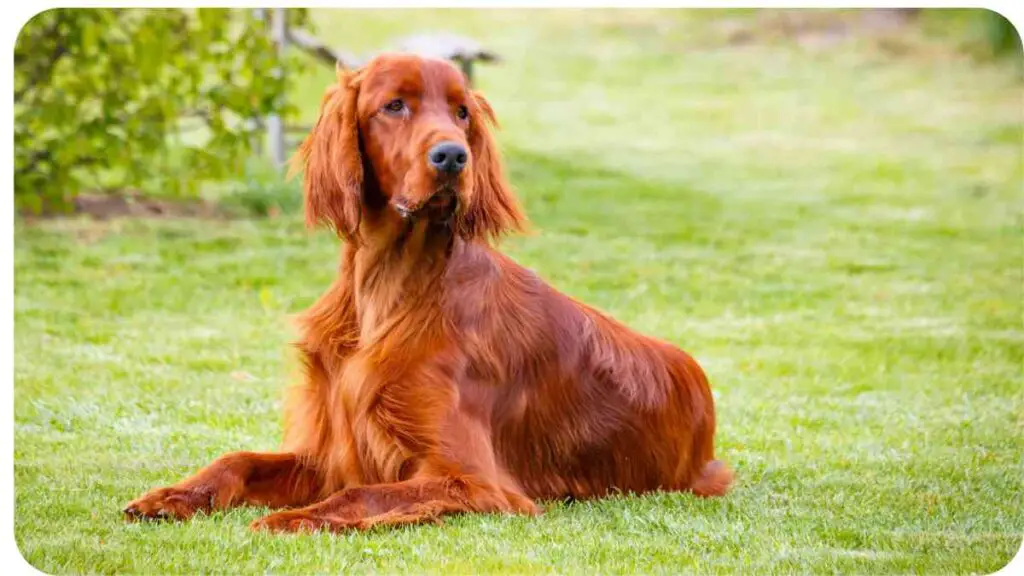Wondering about the ideal size of an Irish Setter’s litter? Dive into this comprehensive guide for all things Irish Setter-related. Dr. Hellen James, a seasoned veterinarian, sheds light on the factors influencing litter size, offering valuable insights for responsible breeding.
From prenatal care to post-birth preparations, discover how to ensure the health and happiness of both mother and puppies. Join us as we explore tips on care, training, and essential considerations for Irish Setter owners, making this a must-read for those seeking a joyful journey with their beloved furry companions.
| Takeaways |
|---|
| Irish Setters can have litters with varying sizes, typically ranging from 5 to 8 puppies. |
| Factors that can affect litter size include genetics, age of the female, and overall health. |
| Proper prenatal care and nutrition are crucial for ensuring the health of the mother and the puppies. |
| Breeding Irish Setters should be done responsibly, taking into consideration the health and temperament of the parents. |
| Consultation with a veterinarian is recommended for accurate information and guidance specific to your Irish Setter. |
Maximizing Irish Setter Litter Size

If you’re curious about the potential litter size of Irish Setters, it’s crucial to understand that various factors influence the outcome. The number of puppies in a litter depends on the age, health, and genetics of the female Irish Setter. While individual cases vary, a typical Irish Setter litter generally falls between 8 and 12 puppies.
For young or first-time mothers, there’s a consideration of physical strength and safety during birthing. Attempting to increase litter size through breeding should be approached responsibly, with experts suggesting waiting until after the female has successfully navigated at least two litters. This ensures both the mother’s well-being and the potential for a larger, healthier litter.
When it comes to the litter size of Kishu Ken, it’s important to understand the factors that can influence the number of puppies. Our comprehensive guide on Kishu Ken litter size provides valuable insights and veterinary advice to help you better understand this unique breed.
Enhancing Irish Setter Litter Size
If you’re aiming to increase the litter size of your Irish Setter, focusing on their nutrition and exercise is key. Provide your dog with a high-quality diet, steering clear of treats that might compromise their health. Opt for wholesome options such as carrots and celery.
Regular exercise is equally vital to ensure your dog maintains the necessary energy levels to carry a larger litter of puppies. This combination of a nutritious diet and consistent physical activity contributes not only to the overall health of the Irish Setter but can positively impact the size and well-being of their litters.
Creating a Safe Haven for Irish Setter Birth

Ensuring a smooth and secure birthing experience for your Irish Setter involves thoughtful preparation. Set up a snug “nest” in a quiet, warm room with ample bedding for comfort. Prioritize cleanliness, avoiding fabrics with loose threads or strings.
Provide your expectant mother with constant access to fresh water, ensuring it’s not too close to her nesting area. Be proactive by having your veterinarian on standby for potential complications during labor or post-birth.
Have essential supplies ready, including extra towels or blankets for immediate post-birth care. Consider a heating pad for added warmth, but exercise caution to prevent any discomfort or harm to the delicate puppies. Keep an old pillowcase handy for transitioning the mother and pups, maintaining cleanliness during the critical early stages of their lives.
Are you curious about the typical litter size of Komondor? Our informative article on Komondor puppies offers expert opinions and helpful tips for breeders and pet owners alike. Discover more about this remarkable breed and their adorable offspring!
Nurturing Irish Setter Puppies
Providing optimal care for your Irish Setter’s puppies involves a combination of attention to their physical needs and regular veterinary check-ups.
- Exercise and Comfort: Ensure the puppies receive ample exercise while also providing a warm and cozy sleeping environment. Regular playtime contributes to their physical development.
- Monitoring Nutrition and Rest: Keep a close eye on the puppies to ensure they are eating well and getting sufficient rest. A balanced diet is crucial for their growth and overall well-being.
- Veterinary Check-ups: Schedule weekly visits to the vet for comprehensive health checks. Early detection of any potential health issues is key to proactive and effective treatment.
Naming Your Irish Setter’s New Arrivals
Selecting names for your Irish Setter’s newborn puppies is an exciting task that allows for creativity and personalization. Here are some tips and suggestions to make the process enjoyable and meaningful:
- Ease of Pronunciation and Spelling: Opt for names that are easy to pronounce and spell. This facilitates communication and ensures a smooth experience, especially if you plan on having multiple pets.
- Inspiration from Famous Figures: Consider naming your puppies after famous people or historical figures. For example, names like “Ronald Reagan” add a touch of uniqueness and significance.
- Sports Team Inspirations: Draw inspiration from your favorite sports team. Names like “Chicago Bulls” infuse a sense of team spirit and fandom into your pet’s identity.
- Pop Culture References: Explore names from TV shows or movies, but exercise caution to avoid duplication. Ensure the chosen name isn’t already associated with another Irish Setter.
| Gender | Popular Names |
|---|---|
| Male | Finn, Riley, Murphy |
| Female | Molly, Sadie, Ruby |
| Unisex | Bailey, Charlie, Max |
Winter Wellness for Irish Setter Puppies
Ensuring the well-being of your Irish Setter’s puppies during the winter months involves a combination of warmth, comfort, and proper nutrition. Follow these guidelines for a happy and healthy winter:
- Warmth and Dryness: Shield your puppies from the cold by keeping them warm and dry. Avoid drafts, provide ample blankets for cuddling, and be ready for plenty of belly rubs to keep them cozy and content.
- Feeding Routine: Maintain a consistent feeding schedule, offering meals at least twice a day. Adequate nutrition is crucial for their overall health and energy levels, providing the stamina needed for playtime and outdoor activities.
If you’re considering breeding Karelian Bear Dogs, it’s important to have an understanding of their typical litter size and other related factors. Our dedicated article on Karelian Bear Dog litters provides expert insights and practical advice to help you navigate the breeding process successfully.
Seamless Potty Training for Your Puppy
Mastering potty training for your puppy requires a combination of consistency and a secure environment. Here’s a foolproof approach to ensure success:
- Frequent Outdoor Breaks: Take your puppy outside every hour to encourage proper potty habits. Consistent outings minimize accidents and reinforce the association between the outdoors and bathroom breaks.
- Crate Training: Consider using a crate, especially when you need to leave the puppy alone. This prevents accidents and helps instill a sense of routine and discipline.
- Safe Environment: Ensure the room or area where you keep your puppies is free from potential hazards. Remove chemicals or dangerous items to prevent your pup from getting into trouble when left unattended.
Managing Irish Setter Shedding

Irish Setters are characterized by moderate shedding, and while they don’t have an excessive amount of hair, there are key considerations for grooming:
- Moderate Shedding Level: Irish Setters typically have a moderate level of shedding. Understanding their shedding pattern helps manage grooming expectations.
- Seasonal Shedding: Shedding may increase during seasonal coat changes. Recognizing and addressing these periods with proper grooming is essential.
- Feathering: The breed’s long feathering on ears, chest, and tail may shed. Regular brushing is beneficial to manage and reduce shedding in these areas.
- Grooming Needs: Irish Setters require regular grooming to maintain their coat. Brushing, especially during shedding seasons, helps manage waves and keeps the coat healthy.
| Shedding Level | Description |
|---|---|
| Moderate | Irish Setters have a moderate level of shedding. |
| Seasonal | Shedding may increase during seasonal coat changes. |
| Feathering | The breed’s long feathering on ears, chest, and tail sheds. |
| Regular Brushing | Regular brushing can help manage and reduce shedding. |
| Grooming Needs | The breed requires regular grooming to maintain their coat. |
Understanding the Cost of an Irish Setter Puppy
The acquisition cost of an Irish Setter puppy varies based on several factors, offering prospective owners valuable insights into budget considerations:
- Average Cost Range: The average price for an Irish Setter puppy typically falls between $800 and $1,200. This serves as a baseline, but variations exist.
- Reputable Breeder Pricing: Purchasing from a reputable breeder often results in a price range of $1,000 to $2,000, irrespective of the puppy’s gender.
- Non-Reputable Sources: Be cautious when considering non-reputable sources, such as pet stores, where prices may range from $400 to $600, especially for neutered male puppies.
- Geographical Variations: Prices can fluctuate based on your location, with certain regions potentially impacting the overall cost.
Effortless Housetraining for Your Irish Setter Puppy
Embarking on housetraining for your Irish Setter puppy is a pivotal aspect of responsible puppy care, ensuring a harmonious coexistence with your furry friend. Follow these proven techniques for a successful housetraining experience:
- Consistent Outdoor Breaks: Take your puppy outside regularly, especially after meals and naps. Consistent outings establish a routine and reinforce proper bathroom habits.
- Positive Reinforcement: Reward your puppy for successful outdoor bathroom trips. Positive reinforcement, such as treats and praise, creates positive associations with desired behavior.
- Supervision and Crate Training: Keep a close eye on your puppy when indoors, and utilize crate training when you can’t supervise. Crates provide a secure space and discourage accidents.
- Immediate Cleanup: Accidents happen, but immediate cleanup is crucial. Thoroughly clean soiled areas with pet-friendly cleaners to eliminate odors and discourage repeat incidents.
Keeshond puppies are known for their adorable appearance and playful nature. If you’re curious about the litter size of Keeshonds and want to learn more about this lovable breed, our informative guide on Keeshond litter size is a must-read resource for both breeders and prospective pet owners.
Maintaining Cleanliness in Your Puppy’s Litter Box
Efficiently cleaning your puppy’s litter box is essential for their health and comfort. Follow these steps for a hygienic and odor-free environment:
- Daily Cleanup: Ensure daily removal of soiled litter. Use a scoop or shovel to efficiently eliminate waste. Consider disposing of the soiled litter in a trash bag for convenient disposal.
- Weekly Wash: Schedule a weekly thorough cleaning using soap and water. This helps eliminate any lingering odors and prevents bacterial buildup.
- Regular Fresh Litter: Even on non-cleaning days, add fresh litter when replacing the soiled portion. This maintains a clean and inviting space for your puppy.
Ensuring a Clean Environment for Your Puppy
To maintain a hygienic space for your puppy, it’s crucial to know when it’s time to change the litter in their box. Here are key indicators to guide you:
- Visible Signs of Soiling: Change the litter when your puppy starts to poop outside of the designated box. This ensures a clean and sanitary environment for your pet.
- Discomfort Signals: Be attentive to any cues that suggest your puppy is uncomfortable with the current litter. If they show reluctance or displeasure, consider changing the litter to a more suitable option.
- Changes in Waste Characteristics: Pay attention to alterations in the color or odor of your puppy’s waste. If you observe any unusual changes, it’s an indication to refresh the litter promptly.
- Multi-Puppy Considerations: If you have multiple puppies sharing the same litter box, be proactive in cleaning it out with each new addition. Regular maintenance helps control odors and ensures a pleasant environment for all your pets.
| Signs |
|---|
| Unpleasant odor persists |
| Litter clumps no longer form properly |
| Litter appears dirty or soiled |
| Increased frequency of accidents |
| Your puppy shows aversion to the litter |
Decoding Your Puppy’s Emotions
Understanding your puppy’s emotions is crucial for providing proper care and companionship. Here’s how you can tell if your puppy is happy or sad:
- Signs of a Happy Puppy:
- Playful Behavior: Happy puppies are typically active, playful, and full of energy.
- Engagement with Toys: They enjoy activities like chasing their tail, chewing on toys, and exploring their surroundings.
- Mischief and Laughter: Sometimes, their playful antics may lead to a bit of mischief, creating moments of joy for both the puppy and the owner.
- Indications of a Sad Puppy:
- Avoidance Behavior: Sad puppies may avoid interactions with people or other animals.
- Reduced Interest in Play: A decrease in enthusiasm for playing with toys can be a sign of sadness.
- Increased Sleep: Sad puppies might exhibit a desire to sleep more than usual, seeking comfort in rest.
- Vocalizations: Whining or crying when petted or cuddled may indicate emotional or physical distress, such as feeling unwell or being left alone.
Curious about the typical litter size of Kerry Blue Terriers? Our comprehensive article on Kerry Blue Terrier puppies dives deep into this topic, providing valuable insights and expert guidance for breeders and enthusiasts. Discover everything you need to know about this wonderful breed and their adorable offspring!
Ensuring the Well-being of Your Irish Setter Puppy
Keeping a close eye on your Irish Setter puppy’s health is essential for their overall well-being. Here are key indicators to determine if your puppy is in good health:
- Healthy Appetite:
- A robust appetite is a positive sign of your puppy’s well-being. If your pup, especially if under eight weeks old, hasn’t eaten in 24 hours, it’s crucial to consult with a vet promptly.
- Muscle Tone and Body Shape:
- Check for good muscle tone by observing a well-shaped body with rounded hips and shoulders. The puppy should lift its legs effortlessly, and sudden weight loss or gain over time should not be evident.
- Bright and Clear Eyes:
- Healthy puppies exhibit bright, clear eyes that open wide with excitement, particularly during activities like mealtime.
- Clear Nostrils:
- Ensure the nostrils are clear without mucus buildup, as this could indicate potential health issues such as kennel cough, an airborne germ-related infection.
- Oral Health:
- A healthy dog’s mouth should have clean teeth, with white surfaces where they fit together. Avoid overly yellow areas, a sign of plaque buildup. Regular brushing with dog-specific toothpaste helps maintain oral hygiene.
Conclusion
In conclusion, we trust that this guide has provided valuable insights into caring for your Irish Setter puppy. We understand the dedication required in raising a puppy and aim to offer comprehensive assistance.
From understanding litter size to providing optimal care during pregnancy, birth, and beyond, our guide strives to address your queries and concerns effectively. We emphasize the importance of responsible pet ownership, including proper nutrition, exercise, and veterinary care.
Your commitment to your Irish Setter’s well-being ensures a fulfilling and healthy companionship for years to come. Should you have further questions or require additional guidance, don’t hesitate to reach out. Here’s to the joyous journey of raising your beloved Irish Setter puppy!
Further Reading
Here are some additional resources for further reading on Irish Setters:
The Local – Irish Setter: A Noble and Elegant Dog: This article provides insights into the characteristics and history of Irish Setters, highlighting their noble and elegant nature.
VetCare Animal Hospital – Irish Setter Breed Info: Explore this comprehensive breed information page to learn more about Irish Setters, including their temperament, health considerations, and grooming needs.
American Kennel Club (AKC) – Irish Setter: The AKC’s breed profile offers a detailed overview of Irish Setters, covering their origin, care requirements, and suitability as a family companion.
FAQs
Here are some frequently asked questions about Irish Setters:
How big do Irish Setters typically grow?
Irish Setters are a medium to large breed, with males standing between 25 to 27 inches tall at the shoulder and females ranging from 23 to 26 inches.
Are Irish Setters good with children?
Yes, Irish Setters are known for their friendly and outgoing nature, which often makes them great companions for children. However, supervision and proper socialization are always recommended when introducing any dog to children.
Do Irish Setters require a lot of exercise?
Yes, Irish Setters are an active breed that requires regular exercise to keep them mentally and physically stimulated. Daily walks, playtime, and access to a securely fenced yard are recommended to meet their exercise needs.
How often should I groom my Irish Setter?
Irish Setters have a beautiful, long, and silky coat that requires regular grooming to keep it healthy and tangle-free. Brushing their coat a few times a week and regular bathing as needed are essential to maintain their appearance.
Are Irish Setters easy to train?
Irish Setters are intelligent dogs but can sometimes exhibit a stubborn streak. With consistent training, positive reinforcement techniques, and plenty of patience, Irish Setters can become well-behaved and obedient companions. Early socialization and puppy training classes are also recommended.

I’m Dr. Hellen James, a professional veterinarian with a deep interest in the ways that litter size affects the health of animals. I’ve spent years studying this subject and performing research on reproduction in many different kinds of creatures.


